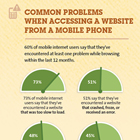People are always looking for ways to improve their websites or applications, and oftentimes we come up with very big and overly complicated ideas on how to do that. Here are some simple ways to greatly improve the user experience of an app.
1. When In Doubt, Make It Faster

For Google, an increase in page load time from 0.4 second to 0.9 seconds decreased traffic and ad revenues by 20%. For Amazon, every 100 ms increase in load times decreased sales by 1%. When the homepage of Google Maps was reduced from 100KB to 70-80KB, traffic went up 10% in the first week, and an additional 25% in the following three weeks.
“Improving speed to make something 25 percent faster is a much more valuable feature than a brand-new feature.“
– Jason Fried
Additional reading
- The Psychology of Web Performance – Web Site Optimization
- Page Load Times vs. Conversion Rates – Gabriel Svennerberg
2. Remove Stuff
“Get yourself fully dressed and then, before walking out the front door, pause by the mirror and remove one item.”
– Coco Chanel
“It’s all about removing the unnecessary.”
– Jonathan Ive, Senior VP of Industrial Design at Apple
Make your app simpler. Remove steps and barriers that users have to go through to accomplish their tasks.
“Feature density is not strongly correlated with user experience.”
– Joe Dwyer, venture capitalist
Users don’t really want features, they want their problems solved. If people aren’t using a particular feature, considering redesigning it, hiding it, or simply removing it. That will bring focus to your core features.
“Every time you make the user make a decision they don’t care about, you have failed as a designer.”
– Aza Raskin
3. Do the Thinking for Me
Or in the words of Steve Krug, Don’t Make Me Think. A good application doesn’t ask me all the ways I would like to get things done. If I don’t name a document, it should create a default name. It makes common-sense assumptions for me for things that I might not care to change or don’t want to deal with right away. Make decisions for the user as much as possible.
“Don’t lose sight of user delight.”
– Mark Pincus
4. Delight Customers
It’s not enough to solve their problem. This is especially true of consumer-facing applications and products. Mark Pincus’ company Zynga has made a successful business in delighting customers by providing games such as FarmVille and CityVille that Facebook users enjoy. But just because you are not making games doesn’t mean you shouldn’t care about delighting users.
5. First Impressions Matter
Just as people form impressions about other people seconds upon meeting them, people also form first impressions about your website in as little as 50 milliseconds. Your website is judged on things such as design, trustworthiness, layout, and color at a very subconscious level.
According to a new University of Melbourne study by Dr. Brent Coker, online consumer trust is largely linked to the visual appeal of websites. People are psychologically hardwired to trust not only beautiful people, but beautiful technology as well.
None of these techniques require years of UX experience, but rather apply simple concepts that can have a meaningful impact on a website. Oftentimes teams can overanalyze their product and try to come up with smart and novel ways to do something for the sake of being innovative. This does not necessarily solve the problem. Just because something can be done doesn’t mean it should.
I will end with one of Dieter Rams’ 10 principles of good design: “Good design is as little design as possible.”





